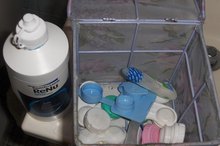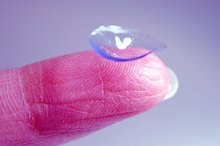How to Wear a Toric Contact Lens
According to the University of Michigan Kellogg Eye Center, astigmatism usually occurs when the front of the eye -- the cornea -- is curved more in one direction than the other 1. The resulting distortion in one’s vision is much like looking in a wavy mirror. Toric contact lenses compensate for this abnormal curvature with an extra curvature of their own 2. Instructions for wearing Toric lenses are almost exactly the same as instructions for wearing normal contacts; the only major difference is that you must make sure that each lens is properly oriented before you put it in your eye.
Wash your hands and dry them with a lint-free towel before handling your contact lenses. Shake your contact lens case gently in case your contacts have adhered to the side or lid. Shaking helps to dislodge the contacts without the risk of damage you’ll encounter if you try to pull them off the case by hand.
How to Tell If Your Contact Lens Falls Out
Learn More
Open one side of the contact lens case, insert your finger into the contact lens solution and lift the contact out. Rinse the contact lens with sterile saline solution. Position the Toric lens on the index finger of the same hand as the eye it’s going in to; if you’re putting the lens in your right eye, position it on the tip of your right index finger.
Lift your finger so that you can view the lens in profile. If it looks like half a ball -- no flaring edges at the top -- it’s right side out. If it looks more like a soup bowl, with flared edges or a rim at the top, it’s inside out. Carefully turn it back right side out. This is only a consideration with soft contact lenses.
How to Remove a Torn Contact Lens
Learn More
Orient the Toric lens so that when you lift your finger to your eye to put the contact in, the thicker or heavier portion of the lens is on the bottom. Some Toric lenses have a small hatch mark, or pair of marks, on the lens to identify the bottom portion.
Hold your eyelids open with your free hand and the middle finger of your hand holding the lens. Look straight ahead as you place the contact directly on your eye. Release your eyelids and blink to seat the contact. Correctly placing the contact is most critical if you wear rigid gas permeable contact lenses; soft contacts are designed to naturally shift into the correct placement as you blink. Repeat Steps 1 through 5, if necessary, to put in the other contact.
Remove your contact lenses at the end of the day. For soft contact lenses this means holding your eyelids open as you very gently pinch the lens together between your index finger and thumb, then lift it off your eye. For rigid lenses, bend over, open your eye wide, and use one finger to pull the skin on the outside corner of your eye straight out toward your ear. Hold your other hand, palm up and open, beneath your eye. Blink. The contact should pop right out into your waiting hand.
Disinfect and store your contact lenses at the end of the day. There are many contact lens disinfecting systems available on the market, each involving a different procedure. The typical process involves gently rubbing each contact in the palm of your hand with a disinfecting solution, rinsing the contact, then storing it in a cleaning solution that may or may not require the addition of extra tablets or drops.
Tips
If your vision suddenly blurs, the Toric lens may have shifted out of alignment. Try blinking rapidly a few times or adding a few moisturizing eye drops to help ease the contact back into place. Make sure the eye drops are safe for use with contacts. If your vision remains blurry, wash your hands, remove the offending contact, rinse it with saline or all-purpose contact solution, then place it back in your eye.
Always carry a small bottle of saline solution with you to rinse your contacts if necessary.
Warnings
You should never rinse your contacts with tap water. Tap water contains a microorganism, Acanthamoeba, that can cause serious eye infections.
Related Articles
References
- University of Michigan: Astigmatism
- AllAboutVision: Toric Contact Lenses
- AllAboutVision: Caring for Contacts
- Kessel L, Andresen J, Tendal B, Erngaard D, Flesner P, Hjortdal J. Toric intraocular lenses in the correction of astigmatism during cataract surgery: a systematic review and meta-analysis. Ophthalmology. 2016;123(2):275-286. doi:10.1016/j.ophtha.2015.10.002
- Federal Trade Commission. The contact lens rule: a guide for prescribers and sellers. Published June 2020.
- Wu YT, Willcox M, Zhu H, Stapleton F. Contact lens hygiene compliance and lens case contamination: A review. Cont Lens Anterior Eye. 2015;38(5):307-316. doi:10.1016/j.clae.2015.04.007
- Cope JR, Collier SA, Srinivasan K, et al. Contact lens-related corneal infections - United States, 2005-2015. MMWR Morb Mortal Wkly Rep. 2016;65(32):817-20. doi:10.15585/mmwr.mm6532a2
- Cope JR, Konne NM, Jacobs DS, et al. Corneal infections associated with sleeping in contact lenses - six cases, United States, 2016-2018. MMWR Morb Mortal Wkly Rep. 2018;67(32):877-881. doi:10.15585/mmwr.mm6732a2
- Lam JSH, Tan G, Tan DTH, Mehta JS. Demographics and behaviour of patients with contact lens-related infectious keratitis in Singapore. Annals Academy of Medicine. 2013;42(10):499-506.
- American Optometric Association. Cost of contact lenses.
Writer Bio
Lisa Maloney is a travel and outdoors writer based in Anchorage, Alaska. She's written four outdoors and travel guidebooks, including the award-winning "Moon Alaska," and regularly contributes to local and national publications. She also has a background in personal training, with more than 6,000 hours of hands-on experience.








